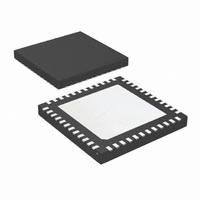LM96194CISQ/NOPB National Semiconductor, LM96194CISQ/NOPB Datasheet - Page 28

LM96194CISQ/NOPB
Manufacturer Part Number
LM96194CISQ/NOPB
Description
IC TRUTHERM HDWR MONITOR 48-LLP
Manufacturer
National Semiconductor
Series
PowerWise®, TruTherm®r
Datasheet
1.LM96194CISQNOPB.pdf
(106 pages)
Specifications of LM96194CISQ/NOPB
Function
Fan Control, Temp Monitor
Topology
ADC (Sigma Delta), Comparator, Fan Control, Multiplexer, Register Bank
Sensor Type
External & Internal
Sensing Temperature
-40°C ~ 85°C, External Sensor
Output Type
SMBus™
Output Alarm
No
Output Fan
Yes
Voltage - Supply
3 V ~ 3.6 V
Operating Temperature
-40°C ~ 85°C
Mounting Type
Surface Mount
Package / Case
48-LLP
Lead Free Status / RoHS Status
Lead free / RoHS Compliant
Other names
LM96194CISQTR
www.national.com
Equation 9
as the MMBT3904 is used. When this “diode” equation is ap-
plied to an integrated diode such as a processor transistor
with its collector tied to GND as shown in
a wide non-ideality spread. This wide non-ideality spread is
not due to true process variation but due to the fact that
Equation 9
TruTherm technology uses the transistor equation,
10, which is a more accurate representation of the topology
of the thermal diode found in an FPGA or processor.
TruTherm should only be enabled when measuring the tem-
perature of a transistor integrated as shown in the processor
of
15.9.1.2 Calculating Total System Accuracy
The voltage seen by the LM96194 also includes the I
age drop of the series resistance. The non-ideality factor, η,
is the only other parameter not accounted for and depends
on the diode that is used for measurement. Since ΔV
proportional to both η and T, the variations in η cannot be
distinguished from variations in temperature. Since the non-
ideality factor is not controlled by the temperature sensor, it
will directly add to the inaccuracy of the sensor. For the Pen-
tium ™ D processor on 65nm process, Intel specifies a
+4.06%/−0.89% variation in η from part to part when the pro-
cessor diode is measured by a circuit that assumes diode
equation,
perature sensor has an accuracy specification of ±2.5°C at a
temperature of 75 °C (348 Kelvin) and the processor diode
has a non-ideality variation of +4.06%/−0.89%. The resulting
system accuracy of the processor temperature being sensed
will be:
and
TruTherm technology uses the transistor equation,
10, resulting in a non-ideality spread that truly reflects the
process variation which is very small. The transistor equation
non-ideality spread is ±0.4% for the Pentium D processor on
65nm process. The resulting accuracy when using TruTherm
technology improves to:
The next error term to be discussed is that due to the series
resistance of the thermal diode and printed circuit board
traces. The thermal diode series resistance is specified on
most processor data sheets. For the Pentium D processor on
65 nm process, this is specified at 4.52Ω typical. The
Figure
T
T
T
ACC
ACC
5, because
ACC
Equation
holds true when a diode connected transistor such
is an approximation.
= ± 2.5°C + (+4.06% of 348 K) = +16.6 °C
= ± 2.5°C + (−0.89% of 348 K) = −5.6 °C
= ±2.5°C + (±0.4% of 348 K) = ± 3.9 °C
9, as true. As an example, assume a tem-
Equation 10
only applies to this topology.
Figure 5
FIGURE 5. Thermal Diode Current Paths
it will yield
Equation
Equation
F
R
S
BE
volt-
is
28
LM96194 accommodates the typical series resistance of the
Pentium D processor on 90 nm process. The error that is not
accounted for is the spread of the Pentium's series resistance,
that is 2.79Ω to 6.24Ω or ±1.73Ω. The equation to calculate
the temperature error due to series resistance (T
LM96194 is simply:
Solving
additional error due to the spread in the series resistance of
±1.07°C. The spread in error cannot be canceled out, as it
would require measuring each individual thermal diode de-
vice. This is quite difficult and impractical in a large volume
production environment.
Equation 11
caused by series resistance on the printed circuit board. Since
the variation of the PCB series resistance is minimal, the bulk
of the error term is always positive and can simply be can-
celled out by subtracting it from the output readings of the
LM96194.
15.9.1.3 Compensating for Different Non-Ideality
In order to compensate for the errors introduced by non-ide-
ality, the temperature sensor is calibrated for a particular
processor. National Semiconductor temperature sensors are
always calibrated to the typical non-ideality and series resis-
tance of a given processor type. The LM96194 is calibrated
for two non-ideality factors and series resistance values thus
supporting the MMBT3904 transistor and the Pentium D pro-
cessor on 65nm process without the requirement for addi-
tional trims. For most accurate measurements TruTherm
mode should be turned on when measuring the Pentium D
processor on the 65nm process the error introduced by the
false non-ideality spread (see
Ideality Factor Effect on
sensor calibrated for a particular processor type is used with
a different processor type, additional errors are introduced.
Temperature errors associated with non-ideality of different
processor types may be reduced in a specific temperature
Equation 11
can also be used to calculate the additional error
for R
20194443
PCB
Accuracy). When a temperature
equal to ±1.73Ω results in the
Section 15.9.1.1 Diode Non-
ER
) for the
(10)
(11)










